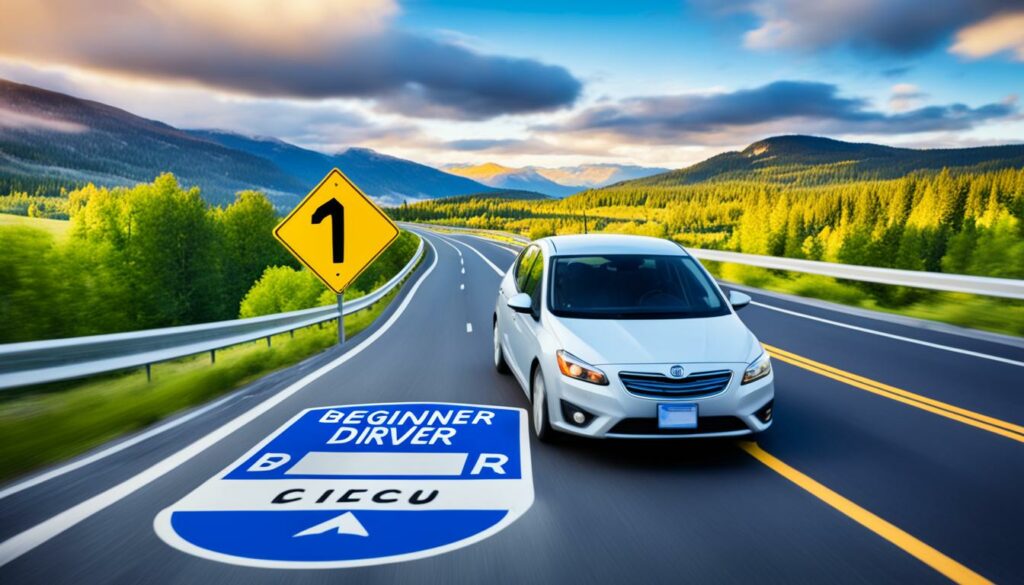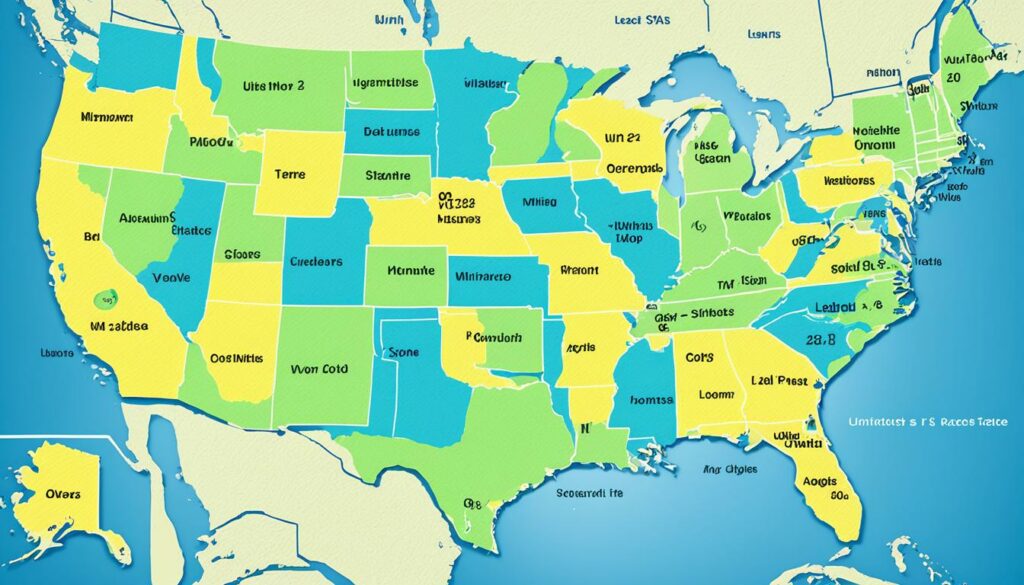Can You Drive at 15? U.S. Learner’s Permit Guide
Are you a teenager eager to get behind the wheel? Wondering if you can start driving at the age of 15? Let’s dive into the world of learner’s permits and explore the legal driving age, age restrictions, and underage driving laws in the United States.
Obtaining a driver’s permit, also known as a learner’s permit, is the first stepping stone towards getting your full driver’s license. While the legal driving age varies by state, some states do allow 15-year-olds to apply for a learner’s permit. However, it’s important to note that they must always be accompanied by a fully licensed adult driver when behind the wheel.
To obtain a learner’s permit, you’ll need to provide proof of identity, pass a written knowledge exam, and pay the required fee. The process may differ slightly depending on the state you reside in. So, let’s explore further to understand the specific driving age requirements and teenage driving regulations in your state.
Key Takeaways:
- Driving age requirements vary by state, with some states allowing learners as young as 15.
- A learner’s permit requires the presence of a fully licensed adult driver in the vehicle at all times.
- Obtaining a learner’s permit involves passing a written knowledge exam and providing proof of identity.
- Teenage driving regulations aim to enhance safety and minimize the risks associated with inexperienced drivers.
- Always prioritize safety and follow the driving rules and restrictions imposed by your learner’s permit.
How U.S. Teenage Driver Licensing Works
Obtaining a driver’s license in the U.S. involves a step-by-step process that varies from state to state. Understanding the requirements and steps involved is crucial for aspiring teen drivers. Here’s a breakdown of how U.S. teenage driver licensing works:
Step 1: Study the Driver’s Handbook and Pass the Written Exam
The first step in getting a driver’s license is mastering the rules and regulations of the road. Prospective drivers must study their state’s driver’s handbook, which covers essential topics such as traffic laws, road signs, and safe driving practices. After studying, they need to pass a written knowledge exam to demonstrate their understanding.
Step 2: Complete Supervised Driving Hours
Once the written exam is passed, teen drivers must fulfill a certain number of supervised driving hours. This can be done either by driving with a licensed adult, such as a parent or guardian, or through formal driver’s education classes. The purpose of supervised driving is to gain practical experience and develop essential driving skills.
Step 3: Take the Driving (Road) Test
After meeting the supervised driving requirements, teens can take the driving test. This test evaluates their ability to handle real-life driving scenarios and assesses their understanding of traffic rules, defensive driving techniques, and proper vehicle operation. Passing the driving test is a significant milestone on the journey to obtaining a driver’s license.
Step 4: Provisional License and Graduated Restrictions
Upon successfully passing the driving test, teen drivers are typically granted a provisional license. This provisional license comes with certain restrictions aimed at gradually increasing driving privileges while ensuring safety. The specific restrictions vary by state but commonly include limitations on nighttime driving, passenger restrictions, and restrictions on the use of electronic devices while driving.
Step 5: Gain Experience and Full License Eligibility
During the period of holding a provisional license, teen drivers gain valuable driving experience under the supervision of an experienced driver. The restrictions imposed are gradually lifted as they accumulate more hours behind the wheel and demonstrate responsible and safe driving behavior. The time required to obtain a full driver’s license varies by state.
Throughout each step of the process, it is essential for teenage drivers to follow the rules and regulations set forth by their state’s driver licensing authority. This ensures their own safety and the safety of others on the road.
| Steps for U.S. Teenage Driver Licensing | Requirements |
|---|---|
| Step 1: Study the Driver’s Handbook and Pass the Written Exam | Knowledge of traffic laws and passing a written exam |
| Step 2: Complete Supervised Driving Hours | Driving under the guidance of a licensed adult or through formal driver’s education classes |
| Step 3: Take the Driving (Road) Test | Demonstrate practical driving skills and knowledge of traffic rules |
| Step 4: Provisional License and Graduated Restrictions | Drive with certain restrictions such as nighttime driving and passenger limits |
| Step 5: Gain Experience and Full License Eligibility | Gradually accumulate driving experience and follow state-specific requirements for obtaining a full driver’s license |
Obtaining a driver’s license is an exciting milestone for teenagers. It signifies newfound independence and the ability to navigate the open road responsibly. By following the proper steps and adhering to licensing requirements, U.S. teenage drivers can embark on a journey towards safe and confident driving.
Learner’s Permit Basics: What, Where, How, and Why

A learner’s permit is a limited driver’s license that allows individuals who are first learning to drive to practice under certain conditions. It serves as an important stepping stone towards obtaining a full driver’s license. If you’ve ever wondered “what is a learner’s permit?” or “how can I get one?”, this section covers all the essential details you need to know.
What is a Learner’s Permit?
A learner’s permit, also known as a learner’s license or provisional license, is a document that grants individuals the legal authorization to operate a motor vehicle under specific circumstances. It is a requirement in most states for individuals who have never driven before. With a learner’s permit, new drivers can gain supervised driving experience and gradually enhance their skills before obtaining a full driver’s license.
Learner’s Permit Requirements
To be eligible for a learner’s permit, you must meet certain requirements set by your state’s Department of Motor Vehicles (DMV). While the specific requirements may vary, common criteria include:
- Being a certain age, typically between 14 and 16 years old.
- Providing proof of identity, such as a birth certificate or passport.
- Passing a written knowledge test that assesses your understanding of road signs, traffic laws, and safe driving practices.
- Paying the required application fee.
Where to Get a Learner’s Permit
Learner’s permits can be obtained at local Department of Motor Vehicles (DMV) offices. These offices are responsible for issuing driver’s licenses and learner’s permits. Visit your state’s DMV website or contact your local DMV office to find out the specific application process and the documents you need to bring.
How to Apply for a Learner’s Permit
The process of applying for a learner’s permit typically involves the following steps:
- Study your state’s driver’s manual to prepare for the written knowledge test.
- Visit your local DMV office and complete an application form.
- Provide the necessary documents to prove your identity and age.
- Take the written knowledge test and pass it by scoring above the required threshold.
- Pay the application fee.
- Have your photograph taken for your learner’s permit.
It’s important to note that the application process may vary slightly from state to state. Therefore, it’s crucial to check your state’s specific requirements and procedures when applying for a learner’s permit.
Preparing for Your Permit Test the Right Way

Adequate preparation is essential for passing the permit test. Whether you’re a first-time driver or looking to renew your learner’s permit, thorough studying and practice will increase your chances of success. Here are some tips to help you prepare for your permit test:
- Study your state’s driver’s manual: Familiarize yourself with the rules of the road specific to your state. The driver’s manual contains valuable information on road signs, traffic laws, and safe driving practices.
- Take advantage of practice tests: Online practice tests are a great way to assess your knowledge and identify areas that require further study. These tests simulate the actual permit test and can give you a good idea of what to expect on test day.
- Create a study schedule: Set aside dedicated study time each day or week to review the driver’s manual and practice tests. Consistency is key to retaining information and building confidence.
- Familiarize yourself with road signs: Understanding and recognizing road signs is crucial for safe driving. Take the time to study common road signs and their meanings to ensure you can identify them correctly during the permit test.
- Review traffic laws: Brush up on your knowledge of traffic laws, including speed limits, right of way, and parking regulations. Understanding these laws will help you answer questions related to real-life driving situations.
By following these tips and dedicating time to studying and practice, you’ll be well-prepared for your permit test. Remember, confidence and a solid understanding of the material are the keys to success. Good luck!
Testimonial:
“Studying for the permit test was crucial for my success. I made sure to thoroughly review the driver’s manual and take multiple practice tests. The online practice tests I used were especially helpful in familiarizing myself with the format and types of questions I could expect. Thanks to my preparation, I was able to pass the permit test on my first try!” – Sarah Johnson
Traffic Sign Examples:
| Traffic Sign | Description |
|---|---|
| Stop sign: Requires drivers to come to a complete stop at the designated point. | |
| Yield sign: Indicates that drivers must yield the right-of-way to traffic approaching from other directions. | |
| Speed limit sign: Displays the maximum legal speed drivers are allowed to travel on a particular road or highway. |
Learner’s Permit Restrictions: What You Can and Can’t Do

Learner’s permit holders are subject to various restrictions to ensure safe driving practices. The most significant restriction is that they must always be accompanied by a licensed adult driver when operating a motor vehicle. This requirement allows novice drivers to gain valuable experience under the supervision of an experienced driver.
In addition to adult supervision, there are other restrictions for learner’s permit holders. These may include limitations on the number of passengers allowed in the car, specific driving hours, and mandatory use of seat belts. These restrictions are in place to minimize distractions, reduce the likelihood of accidents, and promote safe driving habits.
By limiting the number of passengers, learners can focus better on the road without unnecessary distractions. It also helps prevent overcrowding in the vehicle, which can increase the risk of accidents.
Specific driving hours may be imposed to ensure learner drivers are not driving during peak traffic times or in adverse weather conditions when their driving skills may be more challenged. These restrictions help learners build confidence and experience gradually, in a controlled environment.
Furthermore, the mandatory use of seat belts is essential for the safety of learner drivers and their passengers. Seat belts significantly reduce the risk of injury or fatality in the event of a collision. Learner’s permit restrictions emphasize the importance of wearing seat belts at all times.
“The restrictions imposed on learner’s permit holders are designed to protect them and others on the road while gaining experience behind the wheel.”
It is crucial for learner’s permit holders to strictly adhere to these restrictions. Violating these restrictions can result in penalties, fines, or even the revocation of the learner’s permit. Learner drivers should prioritize safety, follow the rules of the road, and continue learning and improving their driving skills.
| Restrictions | Description |
|---|---|
| Accompanied by a licensed adult driver | Learner drivers must always have a licensed adult driver present in the vehicle. |
| Limitations on passengers | Learner’s permit holders may have restrictions on the number of passengers allowed in the vehicle. |
| Specific driving hours | Learner drivers may have restrictions on when they can drive, typically excluding late-night or rush-hour driving. |
| Mandatory use of seat belts | Learner’s permit holders and all passengers must wear seat belts at all times. |
Why Are Restrictions Placed on Teen Drivers?

Teen drivers face higher risks of being involved in car crashes, prompting the implementation of restrictions to improve their safety on the road. To address this concern, many states have established graduated driver licensing programs designed to gradually increase driving privileges while ensuring safety and reducing the risk of accidents.
These programs consist of multiple stages that young drivers must progress through before obtaining a full driver’s license. The journey typically begins with obtaining a learner’s permit, followed by a provisional license. Each stage has specific requirements and restrictions aimed at providing teen drivers with valuable experience under controlled conditions.
Through graduated driver licensing programs, teen drivers can gain practical knowledge, develop critical driving skills, and gradually transition into more independent driving. These restrictions not only protect young drivers but also safeguard other road users.
By enforcing restrictions on teen drivers, states aim to:
- Promote safe driving behavior
- Reduce the risk of accidents
- Gradually increase driving experience
- Encourage responsible decision-making on the road
Implementing driving restrictions for teen drivers is a proactive measure that recognizes the need for a controlled learning environment to mitigate risks associated with inexperience. By taking these steps, states strive to ensure that young drivers are prepared to navigate the roads confidently and responsibly.
The Benefits of Graduated Driver Licensing Programs:
The implementation of graduated driver licensing programs provides several benefits, including:
- Increased Safety: Gradual progression allows teen drivers to gain experience with less risk, reducing the likelihood of accidents.
- Enhanced Skill Development: Each stage of the program focuses on specific driving skills, ensuring comprehensive preparation for different road scenarios.
- Supervised Practice: The presence of a licensed adult during the learner’s permit stage ensures guidance and support, promoting safe driving habits.
- Gradual Introduction of Privileges: By gradually lifting restrictions, young drivers can acclimate to increased responsibilities and independence behind the wheel.
Ultimately, graduated driver licensing programs prioritize teen driver safety by providing a structured and educational framework that allows for the gradual acquisition of driving skills and experience.
State-Specific Age Requirements for Learner’s Permits

The age requirements for learner’s permits vary by state, with each state setting its own driving age laws. It is important to understand the specific requirements in your state to determine when you can apply for a learner’s permit.
Some states allow individuals to apply for a learner’s permit as young as 14 years old, while others have a minimum age requirement of 16 or 17. The table below provides an overview of the learner’s permit age requirements in select states:
| State | Learner’s Permit Age |
|---|---|
| California | 15 1/2 |
| Texas | 15 |
| Florida | 15 |
| New York | 16 |
| Pennsylvania | 16 |
Keep in mind that these age requirements are subject to change, so it’s important to check with your local Department of Motor Vehicles (DMV) or equivalent agency for the most up-to-date information.
Regardless of the minimum age requirement for learner’s permits, it is crucial to follow all state-specific driving laws and regulations to ensure the safety of both yourself and others on the road.
State-Specific Driving Age Requirements
In addition to learner’s permit age requirements, states may also have specific driving age requirements for obtaining a full driver’s license. These requirements may include completing a certain number of supervised driving hours, passing a driving test, or reaching a specific age.
For example, in California, a provisional driver’s license can be obtained at the age of 16, provided certain criteria are met. In Texas, a full driver’s license can be obtained at the age of 18 without any additional requirements.
It’s important to familiarize yourself with the driving age laws in your state to know the steps and requirements for progressing from a learner’s permit to a full driver’s license.
Remember, driving is a privilege that comes with responsibilities. Always prioritize safety on the road and adhere to the laws and regulations of your state.
How to Get a Learner’s Permit
If you’re ready to start your journey towards becoming a licensed driver, obtaining a learner’s permit is an important first step. While the process may vary slightly from state to state, there are some general steps that most applicants need to follow.
- Study for the written knowledge test: Before applying for a learner’s permit, you’ll need to study your state’s driver’s manual and prepare for the written knowledge test. This test will assess your understanding of the rules of the road, traffic signs, and driving laws.
- Gather required documents: To apply for a learner’s permit, you’ll typically need to provide proof of your identity, such as a birth certificate or passport, as well as proof of residency, such as a utility bill or lease agreement. Check with your local Department of Motor Vehicles (DMV) for the specific documents required in your state.
- Complete a driver’s education course: Many states require new drivers to complete a driver’s education course, either through a state-approved program or through their high school. This course will cover important topics such as traffic laws, safe driving practices, and defensive driving techniques.
- Obtain parental consent: If you’re under 18 years old, you’ll usually need to have a parent or guardian accompany you to the DMV to provide consent for your learner’s permit application.
- Submit your application: Once you’ve prepared all the necessary documents and completed the required steps, you can submit your learner’s permit application at your local DMV office. Some states may also offer online application options for added convenience.
Keep in mind that these steps are general guidelines, and it’s essential to check with your state’s specific requirements and processes for obtaining a learner’s permit.
Teen Driving Safety Education and Programs
When it comes to teen driving safety, driver’s education courses are an essential component. These courses provide comprehensive training on road signs, traffic rules, hazard awareness, and safe driving practices. They equip young drivers with the knowledge and skills necessary to navigate the roads responsibly.
Teens have the option to enroll in driver’s education courses through various avenues, including their high schools, online platforms, or private programs. These courses are designed to empower teens with the confidence and competence they need to become responsible drivers.
Completing additional driver safety programs can further enhance a teen’s driving skills and knowledge. Defensive driving courses, for instance, focus on teaching advanced techniques to handle unexpected situations and make wise decisions on the road.
By participating in these valuable driver safety programs, teens can gain the necessary experience and knowledge to become safe and responsible drivers.
| Benefits of Teen Driver’s Education Programs |
|---|
| 1. Enhanced knowledge of road signs and traffic rules |
| 2. Improved hazard awareness and defensive driving skills |
| 3. Increased confidence and competence behind the wheel |
| 4. Understanding the importance of responsible driving behavior |
| 5. Learning how to handle unexpected situations on the road |
Driver’s education courses and additional driving programs are valuable investments for teens as they embark on their journey to become licensed drivers. These programs lay the foundation for a lifetime of safe and responsible driving habits.
Teen Driving Restrictions: Nighttime Driving, Passenger Limits, Distracted Driving
In an effort to promote safe driving practices and reduce the risk of accidents, many states have implemented specific restrictions for teen drivers. These restrictions focus on three key areas: nighttime driving, passenger limits, and cellphone use while driving.
Nighttime Driving Restrictions
Teen drivers are often limited in their ability to drive at night. Many states impose curfews during specific hours to reduce the chances of accidents caused by decreased visibility and increased fatigue. These restrictions vary by state and typically require young drivers to be off the roads during certain hours, especially late at night.
Passenger Limits for Teen Drivers
To minimize distractions and ensure the focus is on the road, passenger limits are commonly imposed on teen drivers. These limits restrict the number of non-family members who can be in the vehicle while a teen is behind the wheel. By reducing the potential for peer pressure and excessive noise, these restrictions help young drivers maintain their focus and make safe decisions.
Restrictions on Cellphone Use While Driving
The use of cellphones while driving is a significant cause of distracted driving accidents. To combat this, many states have implemented restrictions on cellphone use for teen drivers. These restrictions typically prohibit the use of cellphones, including texting and talking, while operating a vehicle. By eliminating this distraction, these measures encourage teens to keep their attention on the road, reducing the risk of accidents.
Overall, these teen driving restrictions aim to provide young drivers with a safe and controlled environment to develop their skills and gain experience on the road. The goal is to create responsible and attentive drivers who will prioritize safety throughout their driving journey.
| Teen Driving Restrictions | Nighttime Driving | Passenger Limits | Cellphone Use |
|---|---|---|---|
| Objective | Reduce accidents during low visibility and fatigue | Minimize distractions and peer pressure | Eliminate distracted driving due to cellphone use |
| Key Features | Curfews during specific hours | Limits on non-family passenger numbers | Prohibition of cellphone use while driving |
| Benefits | Enhanced safety during challenging driving conditions | Reduced distractions and noise in the vehicle | Promotion of focused, attentive driving |
Implementing these restrictions is vital to ensure that teen drivers develop safe habits and establish a strong foundation for responsible driving. It is crucial for both parents and young drivers to understand and adhere to these regulations, fostering a culture of safety on the roads.
Parental Involvement and Role Modeling for Teen Drivers
Parents play a vital role in shaping and guiding their teenage drivers. By actively engaging in their teenagers’ driver education, parents can instill important lessons and promote the development of safe driving habits. Teaching teen drivers goes beyond just imparting practical skills; it involves imparting responsible driving attitudes and behaviors that will last a lifetime.
Parental involvement in teen driving extends beyond the initial stages of obtaining a learner’s permit. It starts with setting clear expectations and rules for safe driving and enforcing them consistently. By establishing open lines of communication, parents can discuss the importance of responsible driving, the risks associated with reckless behavior, and the potential consequences of poor decision-making on the road.
One effective way to teach teen drivers is by leading through example. Parents act as role models and should display safe driving behaviors whenever they are behind the wheel. Demonstrating responsible driving habits, such as obeying traffic laws, avoiding distractions, and practicing defensive driving techniques, can influence teenagers’ perception of what constitutes safe and responsible driving.
“As parents, it is our duty to not only teach our teens the mechanics of driving but also instill in them an understanding of the importance of safety and responsibility on the road. By being actively involved in their driving education and serving as positive role models, we can help shape them into responsible drivers.”
Supervision is another critical aspect of parental involvement in teen driving. Graduated driver licensing programs often require a certain number of supervised driving hours, and parents can use this time to provide valuable guidance and constructive feedback. Supervising teen drivers allows parents to identify areas for improvement, reinforce safe driving practices, and address any concerns or challenges that may arise during the learning process.
Setting Ground Rules and Restrictions
In addition to teaching and supervision, parents can set their own rules and restrictions to further enhance the safety of their teen’s driving experience. These guidelines may include limitations on driving during certain hours, restrictions on the number of passengers allowed in the vehicle, and rules on cellphone use while driving.
By imposing these restrictions, parents aim to minimize distractions, reduce the temptation of engaging in risky behaviors, and gradually expose their teens to more complex driving situations as they gain experience and demonstrate responsible behavior on the road.
Support and Communication
Support and open communication are crucial during the learning process. Encouraging teens to share their experiences, concerns, and questions allows parents to provide guidance and offer advice when needed. Creating a supportive environment where teenagers feel comfortable discussing their driving-related challenges helps foster a positive and constructive learning experience.
Additionally, staying informed about updated driving laws, techniques, and safety measures enables parents to adapt their teaching methods and provide accurate information to their teen drivers. Ongoing education ensures that parents are well-equipped to address any emerging challenges and help their teenagers navigate the complexities of the road.
The Impact of Parental Involvement
Parental involvement in teen driving is an invaluable asset that contributes to the overall safety and development of young drivers. By actively participating in their teen’s driver education, parents can instill the necessary skills, knowledge, and attitudes that promote responsible and safe driving practices.
Table: The Importance of Parental Involvement in Teen Driving
| Benefits of Parental Involvement in Teen Driving |
|---|
| Enhancing awareness of traffic laws and regulations |
| Promoting responsible driving attitudes and behaviors |
| Reinforcing safe driving practices through supervision |
| Setting ground rules and restrictions to minimize risks |
| Providing guidance and support during the learning process |
Parental involvement in teen driving serves as a foundation for safe and responsible driver development. By actively engaging in their teen’s driving education, setting ground rules, and acting as role models, parents play an essential role in shaping their teen drivers into safe and responsible road users.
Conclusion
Obtaining a learner’s permit is an important milestone for teenagers on their journey towards becoming licensed drivers. By familiarizing themselves with the age requirements, application process, and restrictions specific to their state, teens can navigate the process smoothly. Key takeaways from this learner’s permit guide include:
– Understanding the age requirements for a learner’s permit in your state is crucial. It is essential to know when you are eligible to apply and begin your driving journey.
– The application process typically involves passing a written knowledge exam, providing proof of identity and residency, and paying the required fee. Familiarize yourself with the specific requirements in your state to ensure a successful application.
– Learner’s permit holders should focus on preparing for the permit test by studying the driver’s manual, taking practice tests, and seeking additional resources. Adequate preparation increases the chances of passing the permit test on the first attempt.
– While driving with a learner’s permit, it is essential to adhere to the restrictions imposed by your state. These restrictions, such as being accompanied by a licensed adult driver and limited driving hours, are designed to ensure safety and provide novice drivers with valuable experience.
– Safety should always be the top priority when behind the wheel. By practicing safe driving habits, following traffic rules, and avoiding distractions, teens can enhance their skills and work towards obtaining a full driver’s license.
Remember, obtaining a learner’s permit is just the beginning of your journey as a driver. Embrace the learning process, stay focused, and always prioritize safety on the road.
FAQ
Can you drive at 15?
Yes, some states in the U.S. allow individuals as young as 15 to apply for a learner’s permit, which is a restricted license that allows first-time drivers to practice driving under certain conditions.
What are the age requirements for a learner’s permit?
The age requirements for a learner’s permit vary by state. Some states allow individuals to apply as young as 15, while others have a minimum age requirement of 16 or 17. It is important to understand the specific driving age laws in your state.
How do you get a learner’s permit?
To obtain a learner’s permit, you typically need to pass a written knowledge test, provide proof of identity and residency, complete a driver’s education course, and obtain parental consent if you are under 18 years old. The application process may vary slightly from state to state.
How can you prepare for the permit test?
Adequate preparation is essential for passing the permit test. You should thoroughly study your state’s driver’s manual, take practice tests to assess your knowledge, create a study schedule, and familiarize yourself with common road signs and traffic rules.
What are the restrictions for learner’s permit holders?
Learner’s permit holders are subject to various restrictions, depending on the state. The most significant restriction is that they must always be accompanied by a licensed adult driver. Other restrictions may include limitations on the number of passengers, specific driving hours, and mandatory use of seat belts.
Why are restrictions placed on teen drivers?
Restrictions are placed on teen drivers due to their higher risk of being involved in car crashes. Graduated driver licensing programs, which have multiple stages with specific requirements and restrictions, are implemented in many states to gradually increase driving privileges while ensuring safety.
What are the nighttime driving restrictions for teen drivers?
Many states impose nighttime driving restrictions on teen drivers, such as curfews during certain hours. These restrictions aim to minimize the risks associated with driving in the dark when visibility is reduced.
How can parents be involved in teaching teen drivers?
Parents play a crucial role in teaching and supervising their teen drivers. They can provide guidance, instruction, and constructive feedback, ensuring teens understand the rules of the road and the responsibilities associated with driving.
What is the importance of teen driving safety education?
Teen driving safety education, including driver’s education courses, plays a vital role in equipping teens with the necessary knowledge and skills for safe driving. Additional driver safety programs, such as defensive driving courses, can further enhance a teen’s driving abilities.
What should I know about state-specific driving age requirements?
Each state has its own driving age requirements. It is important to understand the laws in your state to determine when you can apply for a learner’s permit and progress towards obtaining a full driver’s license.
What are the restrictions on cellphone use while driving for teen drivers?
In many states, there are restrictions on cellphone use while driving for teen drivers. This is to prevent distractions and promote safe driving practices. Teen drivers should be aware of and comply with these restrictions.
Is parental involvement important for teen drivers?
Yes, parental involvement is crucial for teen drivers. Parents can actively participate in their teen’s driving education, provide guidance and supervision, and set rules and restrictions to ensure their teen’s safety on the road.
What are the key takeaways from this learner’s permit guide?
Obtaining a learner’s permit is the first step towards becoming a licensed driver. Age requirements and the application process vary by state. Preparation is key for passing the permit test, and learner’s permit holders have specific restrictions. Graduated driver licensing programs aim to enhance teen driver safety. Parental involvement and teen driving safety education are important for developing safe driving habits.







